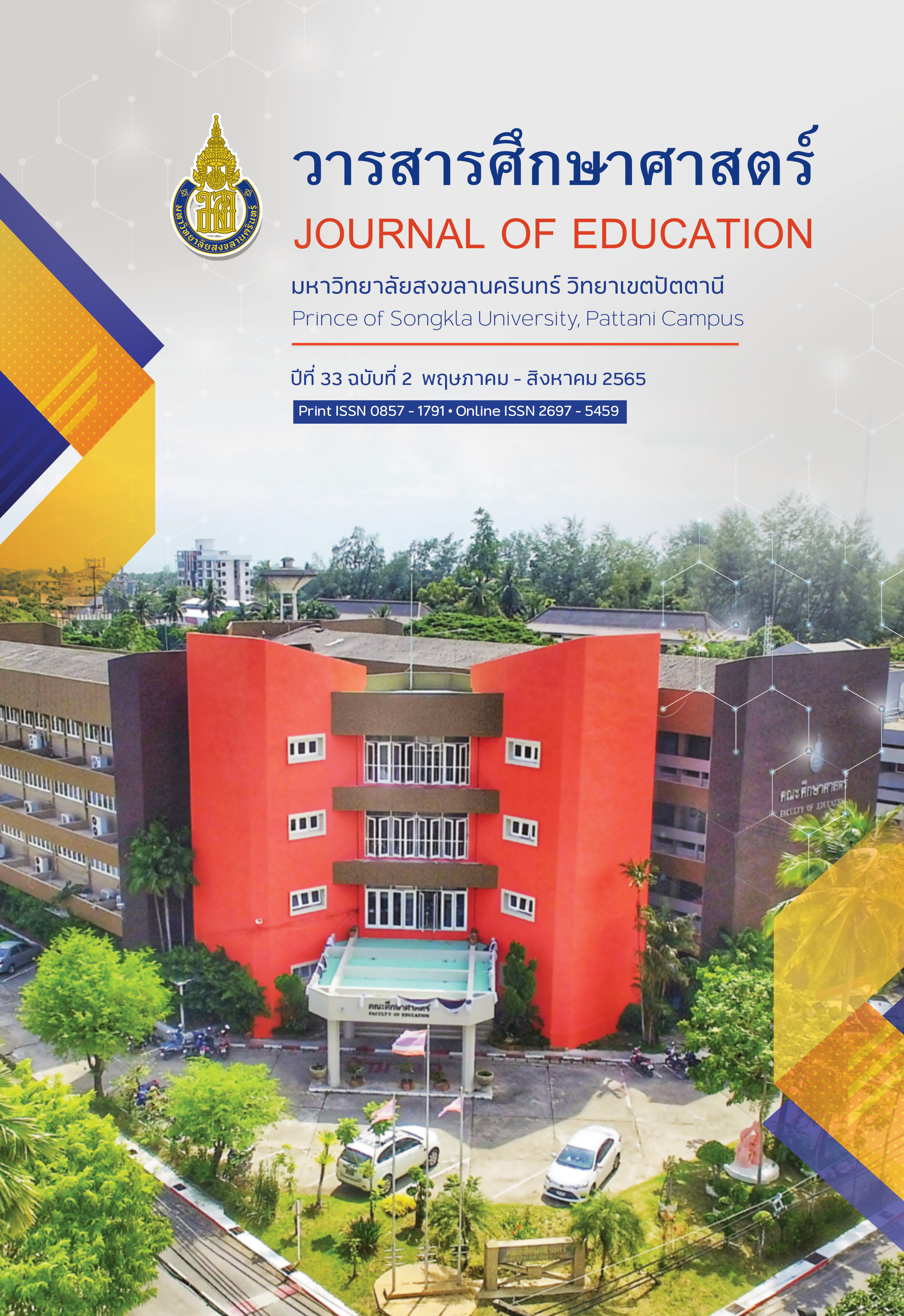เจตคติของนักศึกษาปริญญาตรี สถาบันเทคโนโลยีพระจอมเกล้าเจ้าคุณทหารลาดกระบัง ที่มีต่อเกมกระดานแห่งทักษะการเรียนรู้และนวัตกรรม
Main Article Content
บทคัดย่อ
การวิจัยนี้มีวัตถุประสงค์เพื่อ 1) คัดเลือกเกมกระดานแห่งทักษะการเรียนรู้และนวัตกรรมเข้ามาใช้ในการสอนวิชากีฬาและนันทนาการ สำหรับนักศึกษาปริญญาตรีชั้นปีที่ 1 สถาบันเทคโนโลยีพระจอมเกล้าเจ้าคุณทหารลาดกระบัง โดยสอบถามจากผู้เชี่ยวชาญด้านเกมกระดาน 9 ท่าน ด้วยวิธีเดลฟาย 2 รอบ โดยในรอบที่หนึ่ง เปิดโอกาสให้ผู้เชี่ยวชาญแนะนำเกมกระดานที่คิดว่าเหมาะสม จากนั้นจึงนำผลที่ได้มาให้ผู้เชี่ยวชาญประเมินอีกครั้งด้วยมาตรวัดแบบ 5 ระดับ วิเคราะห์ด้วยสถิติ Friedman และ 2) ประเมินเจตคติของนักศึกษาในวิชากีฬา และนันทนาการ จำนวน 45 คนที่มีต่อเกมกระดานแห่งทักษะการเรียนรู้และนวัตกรรม วิเคราะห์และอภิปรายผลด้วยสถิติเชิงพรรณนา
ผลการวิจัยพบว่า 1) ผลการสอบถามจากผู้เชี่ยวชาญด้วยวิธีเดลฟายรอบที่หนึ่งมีเกมกระดานแห่งทักษะการเรียนรู้และนวัตกรรมที่ถูกแนะนำจำนวน 13 เกม และรอบที่สองจำนวน 8 เกม ได้แก่ Catan, Chinatown, CS-Files, Dixit, Flash Point, Hanabi, Pandemic, Unlock! 2) ผลการประเมินเจตคติของผู้เล่นพบว่า เกมที่ได้ใช้การคิดเชิงวิพากษ์มากที่สุดได้แก่ Unlock! (M = 4.68, S.D. = 0.51) เกมที่ได้ใช้ความคิดสร้างสรรค์มากที่สุดได้แก่ Chinatown (M = 3.85, S.D. = 0.77) เกมที่ได้ใช้ความร่วมมือมากที่สุด ได้แก่ Pandemic (M = 4.56, S.D. = 0.56) เกมที่ได้ใช้ทักษะการสื่อสารมากที่สุดได้แก่ CS-Files (M = 4.31, S.D. = 0.72) และเกมที่เหมาะสมกับระดับทักษะของผู้เล่นมากที่สุดได้แก่ CS-Files (M = 4.31, S.D. = 0.58)
Article Details

อนุญาตภายใต้เงื่อนไข Creative Commons Attribution-NonCommercial 4.0 International License.
เอกสารอ้างอิง
AMA. (2019). AMA Critical Skills Survey: Workers Need Higher Level Skills to Succeed in the 21st Century. Retrieved from American Management Association: https://www.amanet.org/articles/ama-critical-skills-survey-workers-need-higher-level-skills-to-succeed-in-the-21st-century/
Bauza, A. (2010). Hanabi. Retrieved from https://cocktailgames.com/en/cocktailgames/produit/hanabi
Beyer, B. K. (1995). Critical Thinking. IN: Phi Delta Kappa Educational Foundation.
BoardGameGeek.com. (2020). Board Game Mechanics. Retrieved from boardgamegeek.com: https://boardgamegeek.com/browse/boardgamemechanic
Bolstad, R. (2018). Researching game-based learning practices in Aotearoa New Zealand. Set: Research Information for Teachers, 3, 4-11.
Care, E., Kim, H., Vista, A., & Anderson, K. (2018). Education system alignment for 21st century skills: Focus on assessment.
Copeland, T., Henderson, B., Mayer, B., & Nicholson, S. (2013). Three different paths for tabletop gaming in school libraries. Library Trends, 61(4), 825-835.
Csikszentmihalyi, M. (1990). Flow: The psychology of optimal experience. NY: Harper Perennial.
Dewey, J. (1933). Experience and education. NY: Macmillan.
Franco, P. F., & DeLuca, D. A. (2019). Learning Through Action: Creating and Implementing a Strategy Game to Foster Innovative Thinking in Higher Education. Simulation & Gaming, 50(1), 23-43.
Friedman, M. (1937). The use of ranks to avoid the assumption of normality implicit in the analysis of variance. Journal of the American Statistical Association, 32(200), 675-701.
Glaser, E. M. (1942). An Experiment in the Development of Critical Thinking. NY: AMS.
Guilford, J. P. (1973). Characteristics of Creativity. IL: Illinois State Office of the Superintendent of Public Instruction.
Halpern, D. F. (2003). Thought and Knowledge: An Introduction to Critical Thinking. NJ: Erlbaum.
Hämäläinen, R. H., Niilo-Rämä, M., Lainema, T., & Oksanen, K. (2018). How to Raise Different Game Collaboration Activities: The Association Between Game Mechanics, Players’ Roles and Collaboration Processes. Simulation & Gaming, 49(1), 50-71.
Hartwig, K. (1999). Chinatown. Retrieved from https://www.zmangames.com/en/products/chinatown/
Hawkinson, E. (2013). Board Game Design and Implementation for Specific Learning Goals. The Asian Conference on Language Learning 2013 Official Conference Proceedings, (pp. 317-326). Japan.
Hill, C. (2016). Play On: The Use of Games in Libraries. Journal of the Association of Christian Librarians, 59(1), 34-42.
Ho, T. (2014). CS-Files. Retrieved from http://www.greyfoxgames.com/games/deception-murder-in-hong-kong/
ISTE. (2019). ISTE Standards for Students. Retrieved from International Society for Technology in Education: https://iste.org/standards/for-students
Koehler, M. J., Greenhalgh, S. P., & Boltz, L. O. (2016). Here we are, now entertain us! A comparison of educational and non-educational board games. In G. Chamblee, & L. Langlub (Ed.), Proceedings of Society for Information Technology & Teacher Education International Conference (pp. 567-572). Savannah, GA: Association for the Advancement of Computing in Education.
Lanzing, K. (2011). Flash Point: Fire Rescue. Retrieved from http://indieboardsandcards.com/index.php/our-games/flash-point-fire-rescue/
Leacock, M. (2008). Pandemic. Retrieved from https://store.us.asmodee.com/catalogue/pandemic_1135/
Londond, S. (2012). Building Collaborative Communities. In On Collaboration (pp. 75-83). London: Tate.
Mahoney, B. (2017). Gateway Games. Retrieved from Board Game Brother: https://medium.com/board-game-brother/gateway-games-147fb0927b8b
Mayer, B., & Harris, C. (2010). Libraries Got Game: Aligned Learning Through Modern Board Games. American Library Association.
Nakamura, J., & Csikszentmihalyi, M. (2013). Creativity in Later Life. In R. K. Sawyer, Creativity and Development (pp. 186-216). NY: Oxford University Press.
OECD. (2005). The Definition and Selection of Key Competencies. Key DeSeCo publications.
P21. (2019). Partnership for 21st Century Skills's Frameworks & Resources. Retrieved from https://www.battelleforkids.org/networks/p21/frameworks-resources
Paul, R., & Elder, L. (2019). Guide for Educators to Critical Thinking Competency Standards. CA: The Foundation for Critical Thinking.
Petsangsri, S., & Sitthimongkolchai, N. (2020). Play-Based Learning. Journal of Industrial Education, 18(3), 1-6. [in Thai]
Poondej, C., & Lerdpornkulrat, T. (2020). A Study of Gamification Concept of Innovative Learning. Journal of Education Naresuan University, 84-97. [in Thai]
Prabyai, S. (2017). 21st Century Skills for Technical and Vocational Students in Thailand. Journalof Industrial Education, 16(2), 207-214. [in Thai]
Promsri, C. (2016). Using Board Game for Developing Natural Disaster Preparedness Awareness. Panyapiwat Journal, 8(3), 265-279. [in Thai]
Ruengprapan, C. (1996). Basic statistics. Khon Kaen: Khon Kaen University. [in Thai]Roubira, J. L. (2008). Dixit. Retrieved from https://www.libellud.com/dixit/
SpaceCowboys. (2017). Unlock!. Retrieved from https://www.spacecowboys.fr/unlock-english Sternberg, R. J. (2006). The Nature of Creativity. Creativity Research Journal, 18(1), 87-98.
Teuber, K. (1995). Catan. Retrieved from https://www.catan.com/
Torrance, E. P. (1965). Scientific Views of Creativity and Factors Affecting its Growth. Daedalus, 94(3), 663-681.
Torrance, E. P. (1988). The Nature of Creativity as Manifest in Its Testing. In R. J. Sternberg, The Nature of Creativity (pp. 43-75). NY: Cambridge University Press.
Vygotsky, L. S. (1978). Mind in society: The development of higher psychological processes. London: Harvard University Press.
Willet, K. B., Moudgalya, S., Boltz, L. O., Greenhalgh, S. P., & Koehler, M. J. (2018). Back to the Gaming Board: Understanding Games and Education through Board Game Reviews. Proceedings of Society for Information Technology & Teacher Education International Conference, (pp. 495-503). Washington, D.C.
Yuhaniz, M., Samsudin, S. N., Ismail, I., & Mohd Zaki, M. (2018). Student Engagement, Collaboration and Critical Thinking through a Board Game Module in an Architecture History Class. Idealogy, 3(2), 215-223.
Zulkifli, A. A., & Fatimah, S. (2019). Using Werewolf Game to Teach Speaking to Senior High School Students. Journal of English Language Teaching, 8(1), 61-70.


